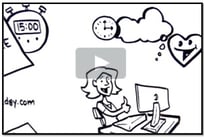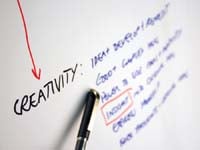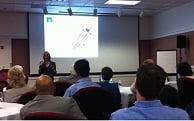Guest blog article written by Kathleen Sexton, Career Counselor, Founder & CEO of Kairos Learning
 Can you list your top 5 strengths easily if someone asked you? Being able to acknowledge your top strengths is very helpful during different phases of your career path.
Can you list your top 5 strengths easily if someone asked you? Being able to acknowledge your top strengths is very helpful during different phases of your career path.
Informational interviewing/networking
During informational interviewing to explore new career opportunities, it’s very helpful to ask the people you’re talking with a question like “I’m very good at strength #1, #2, & #3. Where do you think I could put those to use? What type of career fields or jobs would let me use them frequently?”
Resume development
When you’re creating your resume, you want to highlight your strengths frequently. You can use accomplishment statements to demonstrate your strengths.
Job interviewing
You want to showcase your strengths in your responses to interview questions.
Performance reviews
When you’re talking with your manager about your development plans for the next year, it’s helpful to articulate your top strengths. Talk about how you’d like to use them more and the benefits of doing that for the team as well as your career satisfaction.
If you would like to assess your skills, check out these websites’ online tools:
- VIA Signature Strengths Assessment is a free, online assessment through the University of Pennsylvania’s homepage of Dr. Martin Seligman, Director of the Positive Psychology Center at the University of Pennsylvania and founder of positive psychology, a branch of psychology which focuses on the empirical study of such things as positive emotions, strengths-based character, and healthy institutions. http://www.authentichappiness.sas.upenn.edu
- Skillscan’s Career Driver is an online, self-directed skills assessment tool that provides you with a profile of your transferable skills and preferences — knowledge essential to identifying satisfying work options, creating a career development plan or strategizing your next career move. There are 2 different reports you can get -- Career Launcher Report for individuals planning their first careers or Career Transitioner Report – individuals considering a career change. It’s $14.95. http://www.skillscan.com/
- Marcus Buckingham, a leader the strengths movement, has several assessments out and a new one being released this September. Access to the assessments requires that you to buy his books and then get a link to the online assessments. Now, Discover Your Strengths (Clifton Strengths Finder) and Go Put Your Strengths to Work (Strengths Engagement Test)
Additional Resources
Discovering Your Strengths and Putting Them to Work (60-minute webinar, 7/27, 8:00 am PT)
Career Management in the Age of the Apps (2x60-minute webinars, 7/11, 7/18, 12:00 pm PT)
Social Networking for Career Development (2x90-minute webinars, 8/12, 8/19, 9:30 am PT)







 “I prefer strawberry,” the little girl said, as I tried to hand her pomegranate juice. Such a simple statement but I was struck with how easily she knew her preference and expressed it. It often seemed like I spent thirty years trying to figure out what was acceptable to want, with the end result being that I had no idea what I really wanted. If I didn’t like what others did, I either tried to force myself to go along with it, convince the others why what I wanted was better or analyze what was wrong with me for having different preferences.
“I prefer strawberry,” the little girl said, as I tried to hand her pomegranate juice. Such a simple statement but I was struck with how easily she knew her preference and expressed it. It often seemed like I spent thirty years trying to figure out what was acceptable to want, with the end result being that I had no idea what I really wanted. If I didn’t like what others did, I either tried to force myself to go along with it, convince the others why what I wanted was better or analyze what was wrong with me for having different preferences. Lately, I’ve talked to several people who told me that creative business writing isn’t really practical. Somehow the word creative makes them think it’s silly or frilly or not really useful.
Lately, I’ve talked to several people who told me that creative business writing isn’t really practical. Somehow the word creative makes them think it’s silly or frilly or not really useful.
 I mentioned to you a few weeks ago that I attended a presentation by Christine Heckart, CMO of NetApp, in which she shared some valuable insights, ranging from high level concepts to practical advice on how to lead, manage, and get results. I also talked about one of her insights which was
I mentioned to you a few weeks ago that I attended a presentation by Christine Heckart, CMO of NetApp, in which she shared some valuable insights, ranging from high level concepts to practical advice on how to lead, manage, and get results. I also talked about one of her insights which was  Barry Cardoza's presentation
Barry Cardoza's presentation Barry Cardoza, Certified Business Continuity Professional (CBCP), and Principal of Barry Cardoza LLC, specializes in Business Continuity Program Development, Enhancement and Analytics. Barry has over 40 years of experience in business management, business process analysis, and continuous process improvement. This experience has been within many different industries and includes over 20 years within the banking industry. Previously responsible for Union Bank’s Business Continuity strategy, policy, compliance, and program implementation.
Barry Cardoza, Certified Business Continuity Professional (CBCP), and Principal of Barry Cardoza LLC, specializes in Business Continuity Program Development, Enhancement and Analytics. Barry has over 40 years of experience in business management, business process analysis, and continuous process improvement. This experience has been within many different industries and includes over 20 years within the banking industry. Previously responsible for Union Bank’s Business Continuity strategy, policy, compliance, and program implementation.

 Normally, when we think about vitality, we think about people, about our own vitality and how we can augment it. However, when looking at our business, we can also gauge it in terms of its vitality. The Nine Essentials for Vitality are what the human brain requires to keep us energized, creative, healthy and full of life. Since people create business, the same principals apply the ‘brain’ of your business and can help your business move from surviving to thriving.
Normally, when we think about vitality, we think about people, about our own vitality and how we can augment it. However, when looking at our business, we can also gauge it in terms of its vitality. The Nine Essentials for Vitality are what the human brain requires to keep us energized, creative, healthy and full of life. Since people create business, the same principals apply the ‘brain’ of your business and can help your business move from surviving to thriving. 


